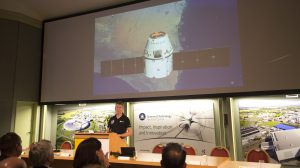The Oxford Academic Health Science Network supported a major event which focused on how world-class work at Harwell and the wider life sciences cluster can lead to improvements in healthcare.
Major Tim Peake, pictured right, spoke about his time on the International Space Station during the event at Harwell Campus on 21 September.
He said: “Keeping humans healthy in space is an extraordinary achievement. This is only possible through collaboration across different disciplines – a winning approach which also works to keep humans healthy on earth.”
Other speakers included:
- Prof Sir John Bell, Regius Professor at the University of Oxford
- George Freeman MP, Chair of the Prime Minister’s Policy Board and former life sciences minister
- Lord Drayson, technology entrepreneur
George Freeman said: “There’s something special happening in Oxfordshire and this cluster. Oxford is on the move.”
Prof Sir John Bell referenced this report published earlier this year into the growth potential of the Oxfordshire ‘innovation engine’.
Tim Peake said he took part in 25 experiments during his six months orbiting the earth providing many insights, particularly around ageing – notably affecting the eyes, muscles and bone density.
The morning concluded with a wide-ranging panel discussion exploring how best to develop multi-disciplinary, cross-sector healthcare activities to benefit society. Frustrations around transport infrastructure and lack of affordable housing were highlighted as challenges holding back further development in Oxfordshire.
Dr Nick Scott-Ram, Oxford AHSN Director of Commercial Development, took part in a workshop led by the Oxfordshire Local Enterprise Partnership which further developed these themes.
The event attracted local, regional and national media interest including:
- Harwell Campus news report
- Oxford Times news report
- BBC Radio 4 Today interview with Prof Sir John Bell (from 54.30 until 20 October)


